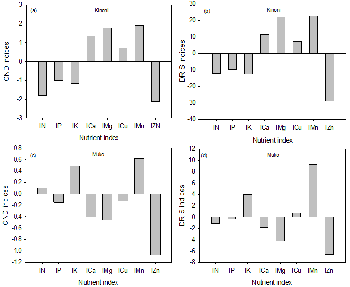Climbing bean is a very important crop in Rwanda especially in the highlands of the Northern Province. However, yields achieved by farmers in the area remain low. This is due to overexploitation of the tiny lands with little or no fertilizer use. A field experiment was established in Kinoni and Muko villages of the Northern Province to identify which nutrients are limiting in climbing, using the Compositional Nutrient Diagnosis (CND) and the Diagnosis and Recommendation Integrated System (DRIS). Climbing bean leaf samples were collected in 56 plots from experimental fields. The 56 samples were collected in treatments with no inputs, with full NPK, with NPK + manure, and with manure only selected from a set of 210 plots, and were analyzed for N, P, K, Ca, Mg, Cu, Mn and Zn. DRIS and CND approaches were applied to rank nutrients according to their degree of limitation to climbing bean. Results suggested that Zn was the most limiting nutrient at both sites. In Kinoni Zn was the most limiting, followed by N, K and P; while in Muko Zn was the most limiting, followed by Mg, Ca, P and N as shown in Figure 1 below.
| This suggests that improvement of soil fertility in Northern Rwanda may target the use of micronutrients in addition to N, P and K, and development of site-specific fertilizer recommendations instead of blanket recommendations. On-farm crop response experiments are needed to confirm whether these nutrients are truly limiting crop production in the field. |
Figure 1: CND (a, c) and DRIS (b, d) nutrient index values for leaf tissue at Kinoni (a, b) and Muko (c, d) sites. |
Edouard Rurangwa, Rwanda Agriculture and Animal Resources Development Board (RAB), Rwanda and Wageningen University, The Netherlands (Click here for his 2018 update)

